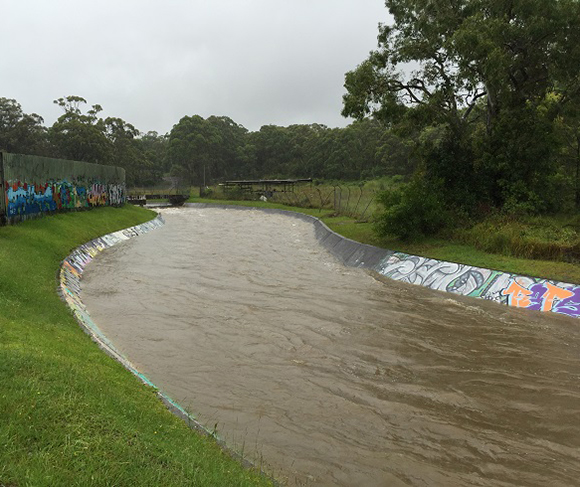Healthy waterways support a healthy environment, society and economy, including more liveable cities and strong, resilient communities.
Thriving aquatic ecosystems, which have strong biodiversity or abundant plants and animals, need healthy waterways. This means stressors such as pollutants and the impacts of development need to be well managed.
Better land-use management improves water quality
The Risk-based framework for considering waterway health outcomes in strategic land-use planning decisions is a protocol that decision makers can use to help manage the impacts of urban development and other land-use activities on waterways in New South Wales. It can be used to:
- find out about community uses and values of waterways and how to meet these values
- identify areas in waterways that need protection from water pollution
- protect aquatic ecosystems from pollution
- work out how to reduce development impacts on waterways, such as improved stormwater management around development sites
- ensure community expectations of waterways are considered in land-use planning
- support management of land-use developments to achieve better socially and economically viable environmental performance.
Water pollution
Diffuse source water pollution arises in a catchment from many different sources rather than a single discharge point.
This type of water pollution mainly results from rainfall run-off, particularly during storms.
Diffuse source water pollution has a big impact on our waterways. In some waterways it is the largest source of pollutants. Sources of pollution include run-off from roads, urban development, construction sites, parks and gardens, and farms.

Stormwater pollution poses significant health risks to humans, plants and animals.
The main pollutants in run-off include:
- chemicals, such as fertilisers and pesticides from agriculture or gardens, heavy metals, oils and other hydrocarbons from road surfaces, detergents and other chemicals
- litter, such as cigarette butts, plastic bags and other rubbish
- sediments, such as soil erosion from construction sites, unsealed roads or riverbanks that lack vegetation
- natural pollution, such as leaves, garden clippings and animal droppings
- salts from dryland salinity and acids from acid sulfate soils in drained wetlands and floodplains
- pathogens, such as viruses and bacteria from leaking septic tanks.
These pollutants can pose significant health risks to humans, as well as plants and animals that live in our waterways.
Point source water pollution comes from a discrete source, such as a pipe or a drain. Industrial waste is often discharged into rivers and the sea in this way. Point source water pollution is mainly managed by the Environment Protection Authority and local councils.
Stormwater pollution
Stormwater is a type of diffuse source water pollution. This surface run-off water and everything it carries with it is a major source of pollution in our waterways.
Rainfall run-off, particularly during storms, is the main cause of stormwater. As water flows over land it picks up pollutants and moves them into rivers, lakes, estuaries, beaches and groundwater.
Stormwater pollution is complex to manage because it is closely linked to land use. The most effective way to reduce stormwater pollution is to prevent it entering the environment.
We work with local councils and environmental regulators to manage urban stormwater – for example, through supporting implementation of the risk-based framework. This includes water-sensitive urban design, which, together with education, help sreduce stormwater pollution at the source.
Another resource the NSW Government developed to help manage stormwater and other diffuse sources of water pollution, the NSW Diffuse Source Water Pollution Strategy, promotes a collaborative approach to reducing stormwater pollution across New South Wales.
Government, councils, industry, landholders and individuals can all help reduce and prevent stormwater pollution. Find out how you can help reduce stormwater pollution.
Report stormwater pollution to your local council.
Stormwater management service charge
Local councils provide stormwater services as part of their role in stormwater management.
Through the Local Government Act 1993, councils can levy a stormwater management service charge (SMSC) on eligible properties to improve stormwater management. This provides additional stormwater services that can help improve the health of urban waterways, reduce the impact of local flooding and promote alternate water sources to reduce demand on potable supplies.
The Office of Local Government oversees implementation of the SMSC. The Stormwater management services charge guidelines (2006) were prepared by the Office of Local Government and the former Office of Environment and Heritage to help councils meet requirements to levy a SMSC.
Erosion control and construction
Controlling soil and sediment on sites where land is disturbed helps maintain the quality of waterways. Soil erosion on building sites can be a major source of sediment pollution in our waterways. A single block of land may seem a small part of a river catchment, but the cumulative effect of polluted run-off from a number of building sites can have a big impact on water quality.
Owners and builders are responsible for controlling soil erosion on a building site and preventing sediment from washing into stormwater drains.
We manage and maintain the 'Managing urban stormwater' series, commonly known as the 'Blue Book', which provides guidance about erosion and sediment control during construction and other land disturbance activities:
- Managing urban stormwater: Soils and construction – Volume 1, 4th edition
- Managing urban stormwater: Installation of services – Volume 2A, Soils and construction
- Managing urban stormwater: Waste landfills – Volume 2B, Soils and construction
- Managing urban stormwater: Unsealed roads – Volume 2C, Soils and construction
- Managing urban stormwater: Main road construction – Volume 2D, Soils and construction
- Managing urban stormwater, Mines and quarries – Volume 2E, Soils and construction.
Heavy fines may be imposed if soil, earth, mud, clay, concrete washings or similar material wash, or are placed in a position where they are likely to be washed, into stormwater drains. This is regulated by the NSW Environment Protection Authority.
Resources
These resources are for use by local councils, water quality managers, developers and planners. They include recommendations for how to control soil and sediment erosion, and develop integrated approaches to this issue: